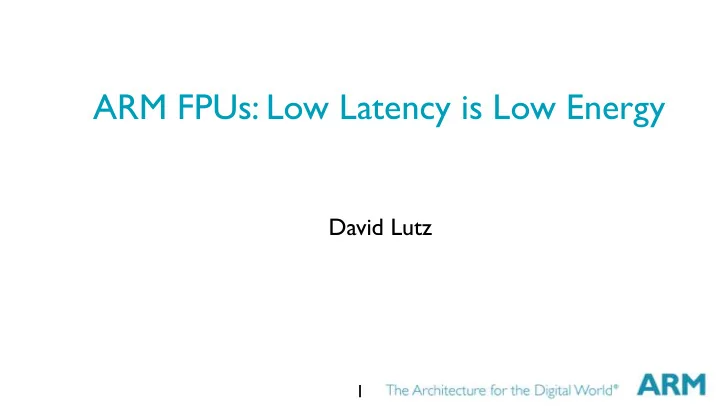

ARM FPUs: Low Latency is Low Energy David Lutz 1
Every computer has a power budget device simple phone smartphone tablet laptop supercomputer total power 3W 5W 15W 35W 20 megawatts budget screen size 3” 4-5” 10” 13” � Power limited by heat generated � Performance increases over time, but power budget does not � Active research area: how to get more performance within a power budget 2
Low Latency is Low Energy Power Energy � Energy = Power * Time Time � Datapaths consume little power on out-of-order cores � Current ARM FPUs consume about 7% of “big” core power running DAXPY � Decreasing latency can decrease time � Energy savings is not just datapath energy 3
Typical 5-cycle FMA � all 3 operands needed at the beginning of the operation � sum of 4 products: s = a*x + b*y + c*z + d*w 1 2 3 4 5 6 7 8 9 10 11 12 13 14 15 16 17 18 19 20 fmul s,a,x M M M M M fma s,b,y F F F F F fma s,c,z F F F F F fma s,d,w F F F F F 4
ARM 6-cycle FMA with separate multiply and add � 3-cycle multiply followed by 3-cycle add � Note that a single FMA is slower � sum of 4 products: s = a*x + b*y + c*z + d*w 1 2 3 4 5 6 7 8 9 10 11 12 13 fmul s,a,x M1 M2 M3 fma s,b,y M1 M2 M3 A1 A2 A3 fma s,c,z M1 M2 M3 A1 A2 A3 fma s,d,w M1 M2 M3 A1 A2 A3 5
opa[63:0] opb[63:0] 3-cycle multiplier 3x siga CLZ siga CLZ sigb V1 0-63 bit left shift 0-63 bit left shift 0-63 bit left shift radix 8 Booth encoder � V1 normalized siga normalized 3x siga BM[17:0] � normalization computed exponent Booth 8 mux � Booth encoding shift, round, V2 and mask 18->12->8->6->4->3->2 (3:2 compressors) generation � V2 D[105:0] E[105:0] mask shift ovfl round round � Booth mux � 18:2 reduction 3:2 3:2 � compute shift,round,mask V3 ovfl sum sum[105:0] � V3 0-63 bit right shift 0-63 bit right shift � add and round (2) last bit and flags last bit and flags sign,ovfl exp sign,exp � subnormal shift rounded ovfl sum rounded sum � select specials sum[105], special 6 product[63:0]
3-cycle adder opa sources opb sources opa sources[63:0] opb sources[116:0] opa_mux opb_mux V1 comparison LZAs � V1 LZAs LZAs LZAs/exp compares � compare/swap larger,shift1 opl,ops opl,ops 4:1 � 4xLZA rshift1 � compute exponent lshift[6:0] opl[106:0] ops[106:0] � compute lshift, rshift right shift exp_diff left shift left shift � V2 V2 � Left and right shift 3:1 3:1 ls,rs,subnormal � select round1 round0 3:2 FA 3:2 FA � 3:2 for rounding c1[107:0] s1[107:0] c0[107:0] s0[107:0] � V3 add1 add0 � add and round V3 specials � select overflow, overflow2 4:1 special sum[63:0] 7
Faster FPU = higher performance and lower energy � Suppose lower latency FPU is 15% faster than higher latency FPU � Takes 1/1.15 = .87 of the time to complete SpecFP time FP power non-FP power energy = time * power Slower FPU 1 7 93 1.0 * (7+93) = 100 Faster FPU 0.87 p 93 .87 * (p+93) = .87p + 80.9 � New scheme lower energy if 100 > .87p + 80.9 � if p < 22 � if p < 3 times slower FPU power 8
Faster FPU can lead to lower area � Fewer (flip)flops vs. more logic � Where is the area going? 9
Strategy for out-of-order cores � Do the execution as quickly as possible to save energy � Be suspicious of slower execution, e.g. � double pumped multipliers � slower dividers � Execution units are where you want to spend power 10
Conclusions � Low execution latency has an outsized effect on performance � Low latency can improve area � Low latency is low energy 11
Recommend
More recommend